Abstract
Most patients with asthma waken with nocturnal asthma from time to time. To assess morbidity in patients with nocturnal asthma nocturnal sleep quality, daytime sleepiness, and daytime cognitive performance were measured prospectively in 12 patients with nocturnal asthma (median age 43 years) and 12 age and intellect matched normal subjects. The median (range) percentage overnight fall in peak expiratory flow rate (PEF) was 22 (15 to 50) in the patients with nocturnal asthma and 4 (-4 to 7) in the normal subjects. The patients with asthma had poorer average scores for subjective sleep quality than the normal subjects (median paired difference 1.1 (95% confidence limits 0.1, 2.3)). Objective overnight sleep quality was also worse in the asthmatic patients, who spent more time awake at night (median difference 51 (95% CL 8.1, 74) minutes), had a longer sleep onset latency (12 (10, 30) minutes), and tended to have less stage 4 (deep) sleep (-33 (-58, 4) minutes). Daytime cognitive performance was worse in the patients with nocturnal asthma, who took a longer time to complete the trail making tests (median difference 62 (22, 75) seconds) and achieved a lower score on the paced serial addition tests (-10 (-24, -3)). Mean daytime sleep latency did not differ significantly between the two groups (2 (-3, 7) minutes). It is concluded that hospital outpatients with stable nocturnal asthma have impaired sleep quality and daytime cognitive performance even when having their usual maintenance asthma treatment.
Full text
PDF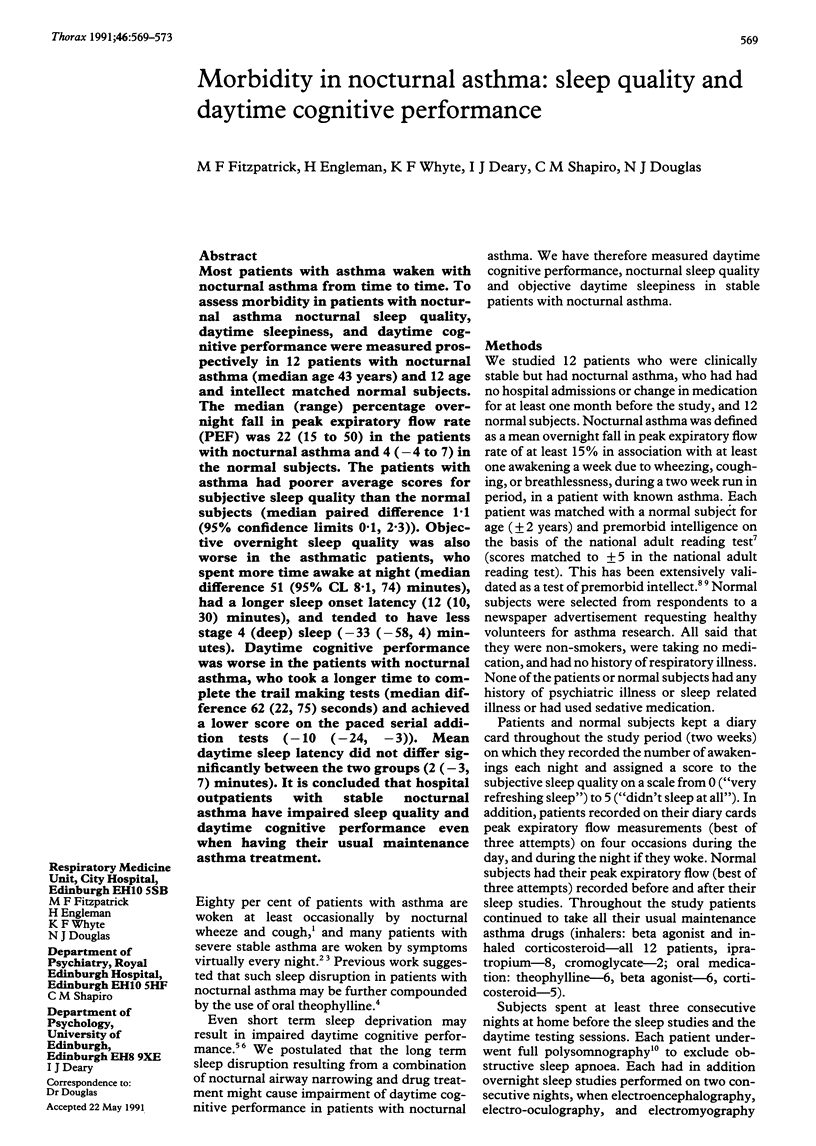
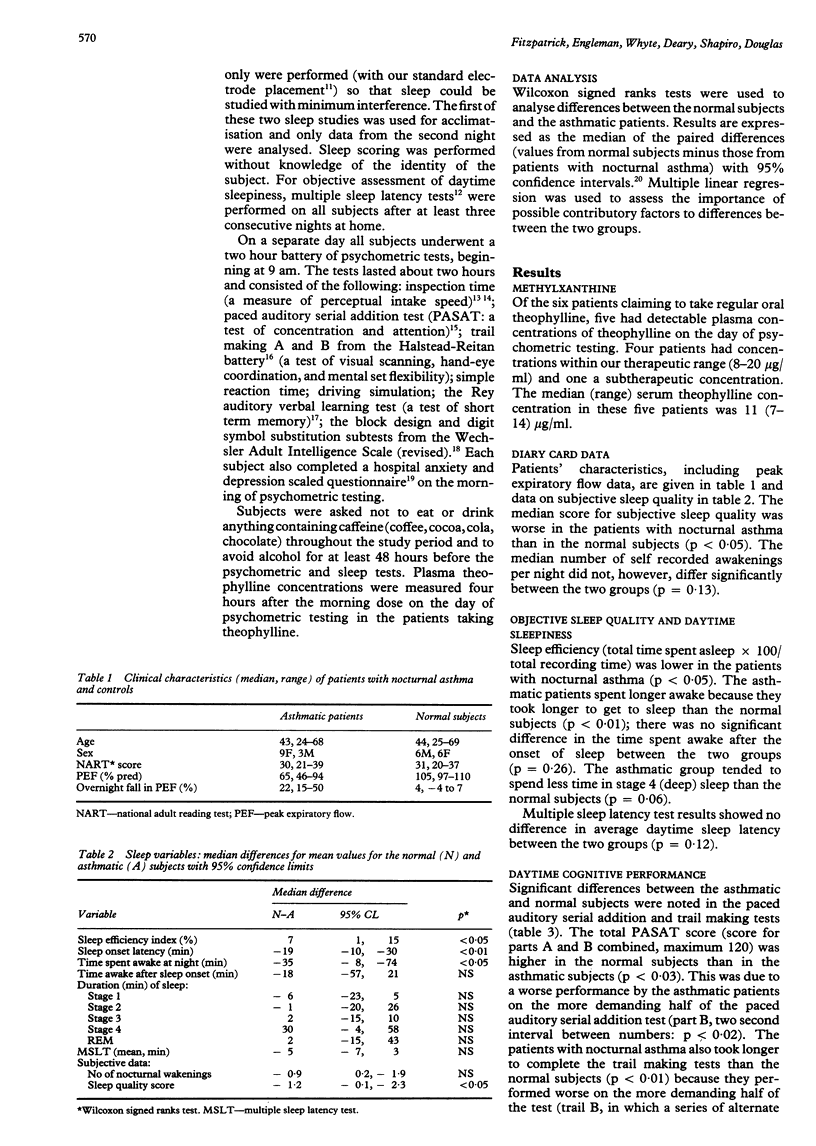
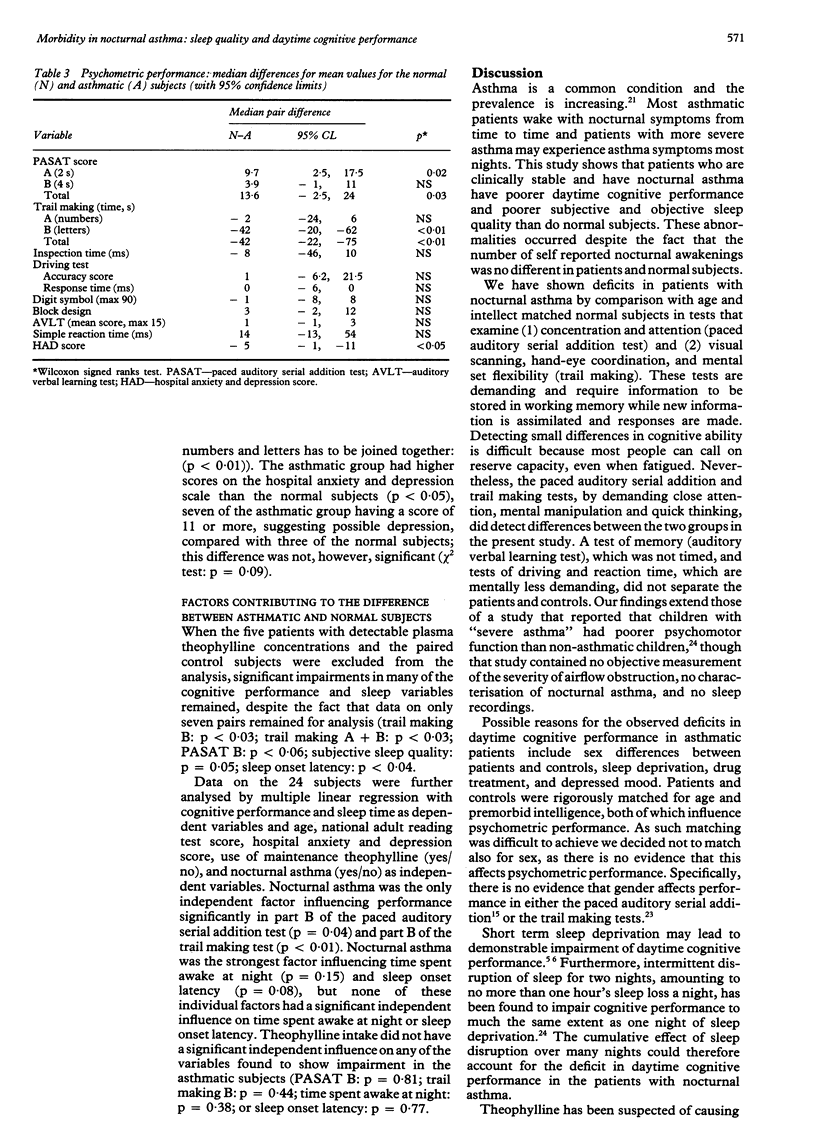
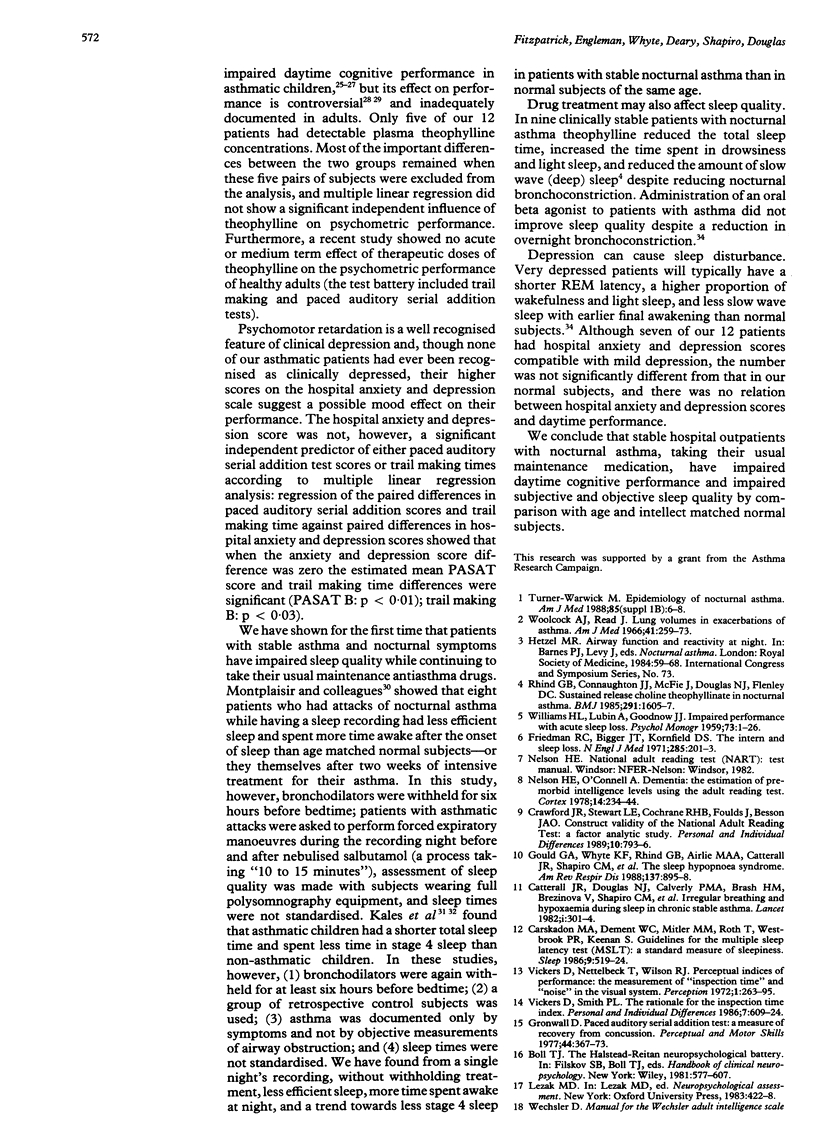
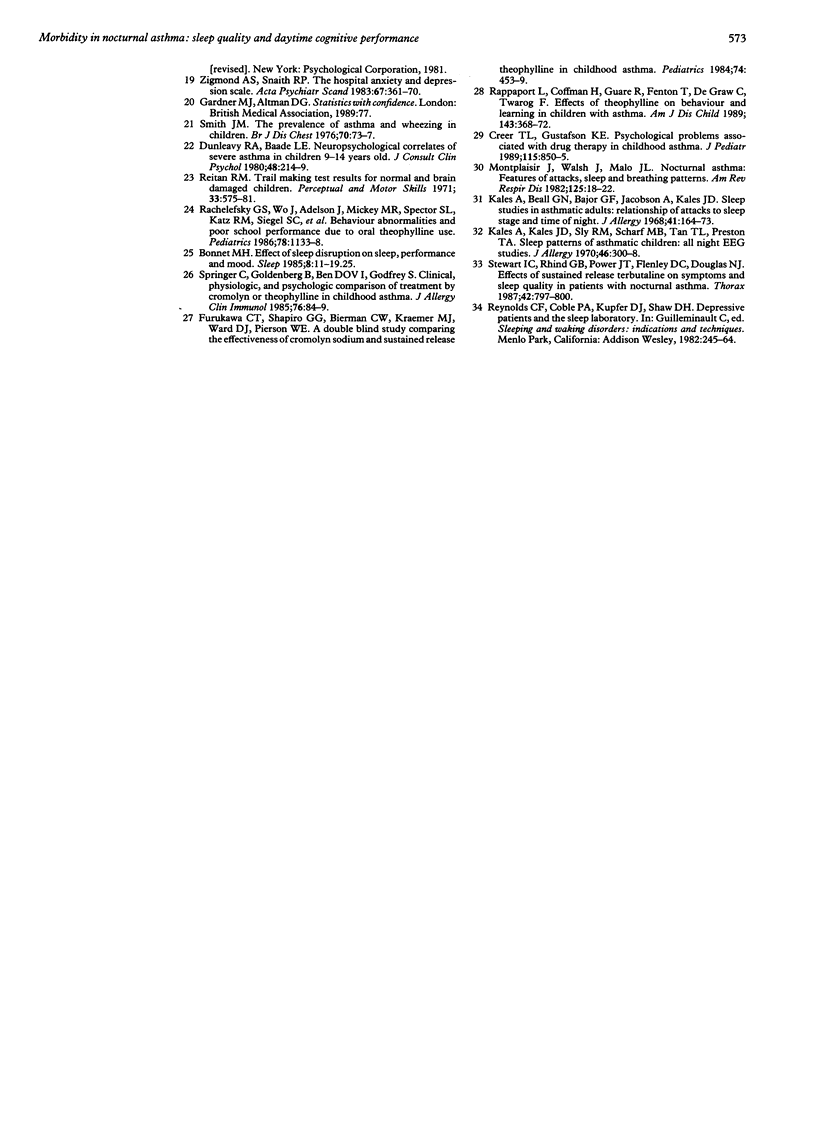
Selected References
These references are in PubMed. This may not be the complete list of references from this article.
- Bonnet M. H. Effect of sleep disruption on sleep, performance, and mood. Sleep. 1985;8(1):11–19. doi: 10.1093/sleep/8.1.11. [DOI] [PubMed] [Google Scholar]
- Carskadon M. A., Dement W. C., Mitler M. M., Roth T., Westbrook P. R., Keenan S. Guidelines for the multiple sleep latency test (MSLT): a standard measure of sleepiness. Sleep. 1986 Dec;9(4):519–524. doi: 10.1093/sleep/9.4.519. [DOI] [PubMed] [Google Scholar]
- Catterall J. R., Douglas N. J., Calverley P. M., Brash H. M., Brezinova V., Shapiro C. M., Flenley D. C. Irregular breathing and hypoxaemia during sleep in chronic stable asthma. Lancet. 1982 Feb 6;1(8267):301–304. doi: 10.1016/s0140-6736(82)91567-7. [DOI] [PubMed] [Google Scholar]
- Creer T. L., Gustafson K. E. Psychological problems associated with drug therapy in childhood asthma. J Pediatr. 1989 Nov;115(5 Pt 2):850–855. doi: 10.1016/s0022-3476(89)80122-2. [DOI] [PubMed] [Google Scholar]
- Dunleavy R. A., Baade L. E. Neuropsychological correlates of severe asthma in children 9-14 years old. J Consult Clin Psychol. 1980 Apr;48(2):214–219. doi: 10.1037//0022-006x.48.2.214. [DOI] [PubMed] [Google Scholar]
- Friedman R. C., Bigger J. T., Kornfeld D. S. The intern and sleep loss. N Engl J Med. 1971 Jul 22;285(4):201–203. doi: 10.1056/NEJM197107222850405. [DOI] [PubMed] [Google Scholar]
- Furukawa C. T., Shapiro G. G., Bierman C. W., Kraemer M. J., Ward D. J., Pierson W. E. A double-blind study comparing the effectiveness of cromolyn sodium and sustained-release theophylline in childhood asthma. Pediatrics. 1984 Oct;74(4):453–459. [PubMed] [Google Scholar]
- Gould G. A., Whyte K. F., Rhind G. B., Airlie M. A., Catterall J. R., Shapiro C. M., Douglas N. J. The sleep hypopnea syndrome. Am Rev Respir Dis. 1988 Apr;137(4):895–898. doi: 10.1164/ajrccm/137.4.895. [DOI] [PubMed] [Google Scholar]
- Gronwall D. M. Paced auditory serial-addition task: a measure of recovery from concussion. Percept Mot Skills. 1977 Apr;44(2):367–373. doi: 10.2466/pms.1977.44.2.367. [DOI] [PubMed] [Google Scholar]
- Kales A., Beall G. N., Bajor G. F., Jacobson A., Kales J. D. Sleep studies in asthmatic adults: relationship of attacks to sleep stage and time of night. J Allergy. 1968 Mar;41(3):164–173. doi: 10.1016/0021-8707(68)90056-7. [DOI] [PubMed] [Google Scholar]
- Kales A., Kales J. D., Sly R. M., Scharf M. B., Tan T. L., Preston T. A. Sleep patterns of asthmaticchildren: all-night electroencephalographic studies. J Allergy. 1970 Nov;46(5):300–308. doi: 10.1016/0021-8707(70)90070-5. [DOI] [PubMed] [Google Scholar]
- Montplaisir J., Walsh J., Malo J. L. Nocturnal asthma: features of attacks, sleep and breathing patterns. Am Rev Respir Dis. 1982 Jan;125(1):18–22. doi: 10.1164/arrd.1982.125.1.18. [DOI] [PubMed] [Google Scholar]
- Nelson H. E., O'Connell A. Dementia: the estimation of premorbid intelligence levels using the New Adult Reading Test. Cortex. 1978 Jun;14(2):234–244. doi: 10.1016/s0010-9452(78)80049-5. [DOI] [PubMed] [Google Scholar]
- Rachelefsky G. S., Wo J., Adelson J., Mickey M. R., Spector S. L., Katz R. M., Siegel S. C., Rohr A. S. Behavior abnormalities and poor school performance due to oral theophylline use. Pediatrics. 1986 Dec;78(6):1133–1138. [PubMed] [Google Scholar]
- Rappaport L., Coffman H., Guare R., Fenton T., DeGraw C., Twarog F. Effects of theophylline on behavior and learning in children with asthma. Am J Dis Child. 1989 Mar;143(3):368–372. doi: 10.1001/archpedi.1989.02150150126032. [DOI] [PubMed] [Google Scholar]
- Reitan R. M. Trail making test results for normal and brain-damaged children. Percept Mot Skills. 1971 Oct;33(2):575–581. doi: 10.2466/pms.1971.33.2.575. [DOI] [PubMed] [Google Scholar]
- Rhind G. B., Connaughton J. J., McFie J., Douglas N. J., Flenley D. C. Sustained release choline theophyllinate in nocturnal asthma. Br Med J (Clin Res Ed) 1985 Dec 7;291(6509):1605–1607. doi: 10.1136/bmj.291.6509.1605. [DOI] [PMC free article] [PubMed] [Google Scholar]
- Smith J. M. The prevalence of asthma and wheezing in children. Br J Dis Chest. 1976 Apr;70(2):73–77. doi: 10.1016/0007-0971(76)90009-7. [DOI] [PubMed] [Google Scholar]
- Stewart I. C., Rhind G. B., Power J. T., Flenley D. C., Douglas N. J. Effect of sustained release terbutaline on symptoms and sleep quality in patients with nocturnal asthma. Thorax. 1987 Oct;42(10):797–800. doi: 10.1136/thx.42.10.797. [DOI] [PMC free article] [PubMed] [Google Scholar]
- Turner-Warwick M. Epidemiology of nocturnal asthma. Am J Med. 1988 Jul 29;85(1B):6–8. doi: 10.1016/0002-9343(88)90231-8. [DOI] [PubMed] [Google Scholar]
- Vickers D., Nettelbeck T., Willson R. J. Perceptual indices of performance: the measurement of 'inspection time' and 'noise' in the visual system. Perception. 1972;1(3):263–295. doi: 10.1068/p010263. [DOI] [PubMed] [Google Scholar]
- Woolcock A. J., Read J. Lung volumes in exacerbations of asthma. Am J Med. 1966 Aug;41(2):259–273. doi: 10.1016/0002-9343(66)90021-0. [DOI] [PubMed] [Google Scholar]
- Zigmond A. S., Snaith R. P. The hospital anxiety and depression scale. Acta Psychiatr Scand. 1983 Jun;67(6):361–370. doi: 10.1111/j.1600-0447.1983.tb09716.x. [DOI] [PubMed] [Google Scholar]


